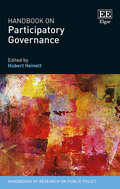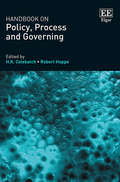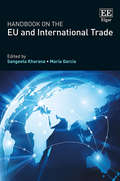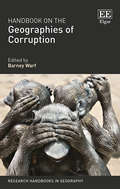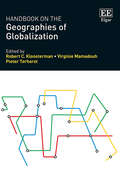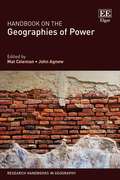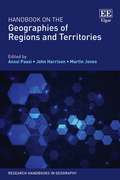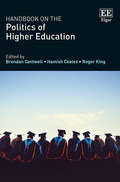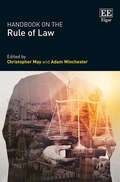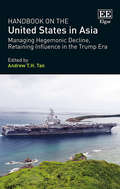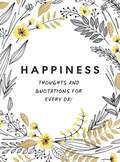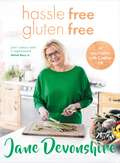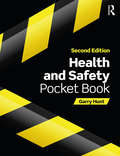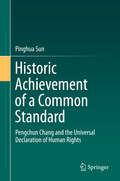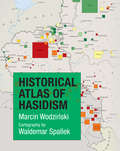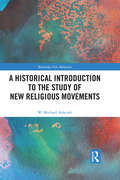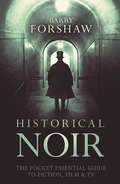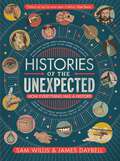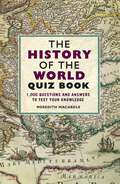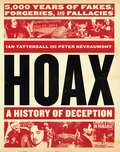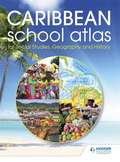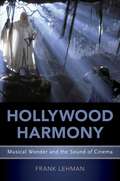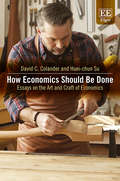- Table View
- List View
Handbook on Participatory Governance (Handbooks of Research on Public Policy series)
by Hubert HeineltCan participatory governance really improve the quality of democracy? Concentrating on democracy beyond governmental structures, this Handbook argues that it is a political task to engage individuals at all levels of governance. The Handbook on Participatory Governance reveals that transforming governance arrangements does in fact enhance democracy and that the democratic quality of participatory governance is crucial. The contributors reflect on the notion of democracy and participatory governance and how they relate to each other. Case studies are presented from regional, national and international levels, to identify how governance can be turned into a participatory form. With chapters reviewing participatory governance’s role alongside power, science and employment relations, innovative ideas for future progress in participatory governance are presented. Academics and postgraduate students with an interest in governance and public policy will find this Handbook a useful guide for further and future research. Practitioners interested in improving citizen participation will also benefit from the insight into increasing participation at every level of governance.
Handbook on Policy, Process and Governing
by H. K. Colebatch Robert HoppeThis Handbook covers the accounts, by practitioners and observers, of the ways in which policy is formed around problems, how these problems are recognized and understood, and how diverse participants come to be involved in addressing them. H.K. Colebatch and Robert Hoppe draw together a range of original contributions from experts in the field to illuminate the ways in which policies are formed and how they shape the process of governing. The Handbook on Policy, Process and Governing covers not only the activities of government, but also the contributions of other stakeholders, and the ways in which a wide range of participants contribute to the formation of public policy. It explores the tensions involved in the policy process between: innovative choice and stable practice, authoritative decision and negotiated order, and agreed activity and announced goals. The scholar’s focus on the analysis of activity and the practitioner’s interest in the achievement of outcomes are brought together in this timely book, making it a valuable read for public policy scholars and practitioners alike.
Handbook on the EU and International Trade
by Sangeeta Khorana Maria GarciaThe legal, political and economic rationales that underpin trade policy are reflected in the establishment and implementation of EU trade relations with the rest of the world. This comprehensive Handbook provides readers with a multidisciplinary overview of the major perspectives, actors and challenges in contemporary EU trade relations. Changes in institutional dynamics, Brexit, the politicisation of trade, competing foreign policy agendas, and adaptation to trade patterns of value chains and the digital and knowledge economy are reshaping the EU trade policy. The authors tackle how these challenges frame the aims, processes and effectiveness of trade policy-making in the context of EU trade relations with developed, developing and emerging states in the global economy. This Handbook presents students and practitioners with an accessible introduction to the policy processes in EU trade policy. Policy-makers, especially those outside of the EU, will also gain key knowledge regarding the trade policies of the EU by reading this.
Handbook on the Geographies of Corruption (Research Handbooks in Geography series)
by Barney WarfThe Handbook on the Geographies of Corruption is a comprehensive overview of corruption, exploring the immense variation of corruption among nations, and how this reflects levels of wealth, the centralization of power, colonial legacies, and different national cultures. In this Handbook, Barney Warf brings together a multidisciplinary and interdisciplinary collection of original new chapters from established researchers and leading academics to examine corruption from a spatial perspective. The Handbook opens with a series of thematic chapters on the causes and consequences of corruption, its geography, the connection between corruption and gender, and the role of e-government in mitigating current corruption issues. Further chapters offer a series of national case studies on countries including Mexico, Brazil, South Africa, Turkey, Russia, Pakistan, China, Indonesia, Ukraine, Bangladesh, and the Philippines from which to draw lessons. This Handbook will be a valuable read for human geography scholars and corruption researchers, wishing to gain a more in-depth understanding of how and why corruption levels differ across the world. Practitioners concerned with combatting corruption would also greatly benefit from reading this given its real-world insights.
Handbook on the Geographies of Globalization
by Robert C. Kloosterman Virginie Mamadouh Pieter TerhorstProcesses of globalization have changed the world in many, often fundamental, ways. Increasingly these processes are being debated and contested. This Handbook offers a timely, rich and critical panorama of these multifaceted developments from a geographical perspective. This Handbook explores the myriad of ways in which differing cross-border flows – of people, goods, services, capital, information, pollution and cultures – have (re)shaped concrete places across the globe and how these places, in turn, shape those flows. With original contributions from worldwide leading scholars, the Handbook positions globalization in a broader historical perspective, presenting a variety of geographical examples so that readers can better understand these processes. Regional studies and economic and human geography scholars will find this an invaluable resource for exploring the key topics of the geographies of globalization. Lecturers and advanced students will also find the detailed case studies useful to help explain the fundamental concepts outlined in the book.
Handbook on the Geographies of Power (Research Handbooks in Geography series)
by Mat Coleman John AgnewThe so-called ‘spatial turn’ in the social sciences has led to an increased interest in what can be called the spatialities of power, or the ways in which power as a medium for achieving goals is related to where it takes place. This unique and intriguing Handbook argues that the spatiality of power is never singular and easily modeled according to straightforward theoretical bullet-points, but instead is best approached as plural, contextually emergent and relational. The Handbook on the Geographies of Power consists of a series of cutting edge chapters written by a diverse range of leading geographers working both within and beyond political geography. It is organized thematically into the main areas in which contemporary work on the geographies of power is concentrated: bodies, economy, environment and energy, and war. The Handbook maintains a careful connection between theory and empirics, making it a valuable read for students, researchers and scholars in the fields of political and human geography. It will also appeal to social scientists more generally who are interested in contemporary conceptions of power.
Handbook on the Geographies of Regions and Territories (Research Handbooks in Geography series)
by Anssi Paasi John Harrison Martin JonesThis major international Handbook offers the most up-to-date and original viewpoints on critical debates relating to the rapidly transforming geographies of regions and territories, as well as related key concepts such as place, scale, networks and regionalism. This interdisciplinary Handbook brings together renowned specialists who have extensively theorized these spatial concepts and contributed to rich empirical research in disciplines such as geography, sociology, political science and international relations. It offers fresh, cutting-edge, and contextual insights on the significance of regions and territories in today’s dynamic world. This is a timely and vital resource for both students and researchers of human geography and regional studies. Political geographers and international relations scholars will also benefit from reading the Handbook as it offers a comprehensive yet accessible examination of the geography of regions and territories.
Handbook on the International Political Economy of Gender (Handbooks of Research on International Political Economy series)
by A. Roberts J. EliasThis comprehensive Handbook showcases the burgeoning and cutting edge research that has come to constitute the study of gender and International Political Economy (IPE). It surveys the diversity of contemporary feminist IPE research, exploring a range of different theoretical and methodological traditions and reviewing the broad empirical scope of this research. The Handbook also critically interrogates the intersections and points of tension between the different disciplines that have inspired contemporary approaches. Expert contributors offer insights into how to the categories of ‘masculine’ and ‘feminine’ have been established and maintained globally, while also documenting and challenging the privileging of the former over the latter in different sites and spaces. They further show how gender power relations are shaped by race, nationality, sexuality, class, and more. The Handbook explores and demonstrates how gender operates as a relation of social power in the global political economy. The Handbook on the International Political Economy of Gender will appeal to undergraduate and post-graduate students of politics and international relations, security studies, development studies, economics, and gender and queer studies, as well as policymakers and practitioners interested in issues of global (in)equality and development.
Handbook on the Politics of Higher Education
by Brendan Cantwell Hamish Coates Roger KingThe Handbook on the Politics of Higher Education reveals valuable new perspectives for understanding higher education. Higher education plays an ever-greater role in contemporary life, creating innovation, skills, prosperity, and wellbeing, and is therefore of increasing importance to understand. Crafted as a sophisticated entry point, this Handbook takes a wide look at the topic, the state of contemporary research, and future directions. An array of expert international contributors examine important and contentious issues such as who should pay, how to keep higher education accountable, the assurance of quality, boosting productivity and affordability, and the role of states and markets. Experts explain how universities relate to states and societies, the political economy of higher education, planning and resource allocation, regulation and quality, and the politics of stakeholder interests. Unpacking key issues for both researchers new to the sector and experts alike, this topical Handbook will prove essential and thought-provoking reading for government policymakers, social science researchers, higher education executives, as well as instructors of graduate courses.
Handbook on the Rule of Law
by Christopher May Adam WinchesterIn the last half century, the rule of law has increasingly been appealed to as a common global value. The Handbook on the Rule of Law analyses the appeal of this idea, its context and background through a range of questions about the character, history and global reach of the rule of law, offering readers a definitive understanding of this central global norm. Original contributions from leading academics explore the rule of law conceptually and historically through its associated institutions, as well as examining detailed cases evaluating how the everyday application of the rule of law impacts society as a whole. Exploring a wide range of research on the social, political and economic dimensions of the rule of law, this Handbook clearly illustrates the link between the rule of law and the global political system. This informative Handbook will be key reading for postgraduate students of international relations, global politics and law, as well as for legal scholars wanting to build upon their knowledge with a wider account of the rule of law. Researchers in areas impacted by the rule of law will also find this volume to be stimulating reading.
Handbook on the United States in Asia: Managing Hegemonic Decline, Retaining Influence in the Trump Era
by Andrew T. H. TanThe centre of gravity in today’s global economy arguably now resides in Asia. As a result of this, the maintenance of geopolitical and economic security in Asia has become pivotal to global stability. This indispensable Handbook examines the crucial and multifaceted role of the United States as a force in the region that has been, and continues to be, necessary for the continuation of Asian prosperity. The Handbook on the United States in Asia moves the academic discussion away from the fixation on America’s influence in terms of the China threat. It provides readers with comprehensive and informed coverage from expert international contributors on the engagement of the United States with a wide array of Asian countries. The Handbook examines America’s relationship with key allies as well as its multifaceted role and presence in the region. It also explores ways in which this is changing under Donald Trump’s presidency. The policy-orientated focus of this Handbook ensures that academic and governmental policy analysts will greatly benefit from the timely and comprehensive assessment of the book. Undergraduate and postgraduate international relations students, as well as Asian studies scholars, will also find it to be an excellent tool for study.
Happiness: Thoughts and Quotations for Every Day
by Summersdale PublishersImmerse yourself in the uplifting pages of this beautiful little book, filled with inspiring and motivational quotes from the world’s best writers, leaders and thinkers.Within this charming volume you will find a dose of happiness on every page. Featuring the wise words of luminaries ranging from Emily Dickinson to Mahatma Ghandi, and from Leo Tolstoy to Lao Tzu, this book will inspire your heart and ease your mind, helping you to see beauty in the everyday and inviting you to bask in the glow of positive thinking.With one pearl of wisdom per page, this book is the perfect gift for anyone who is looking for a spark of inspiration. It’s a pocket-sized reminder that there is joy to be found all around us.Happiness makes up in height for what it lacks in length.Robert FrostFind ecstasy in life; the mere sense of living is joy enough.Emily DickinsonThe best way to cheer yourself up is to try to cheer somebody else up.Mark Twain
Hassle Free, Gluten Free: Over 100 delicious, gluten-free family recipes
by Jane Devonshire'I hope that first and foremost this book is just a series of recipes that you can use for every day cooking; be it for a special occasion or a simple family supper. It's the things I cook and the little twists that I add that make my life easier and hopefully tastier; it just happens to be gluten free.'In her debut cookbook, Jane Devonshire presents 100 delicious recipes guaranteed to make you feel good, and wow family and friends. In chapters such as nibbles and small dishes or dinner and food for guests, Jane offers recipes from soups and dips to casseroles, arancini and delicious salads. Desserts include Chinese-style caramelized pineapple and a much-loved classic of steamed sponge pudding, while Jane also includes a chapter on baking (notoriously tricky for those on a gluten-free diet), from brownies to muffins and everything in between. Published to coincide with their 50th anniversary, the recipes are gluten-free and tested by Coeliac UK. Beautiful photography by Mike Cooper appears throughout.
Health and Safety Pocket Book
by Garry HuntThe second edition of the Health and Safety Pocket Book has been fully revised and updated to include all the relevant legal, HSE ACoP/Guidance and practice references. It remains a handy reference tool for practising health and safety professionals, auditors, managers, HR personnel, employee representatives and anyone with health and safety responsibilities.The book is an essential compilation of guidance, data and checklists covering a wide range of health and safety topics, supported by extensive key glossary terms. The A–Z arrangement within the chapters and extensive cross-referencing make it easy to navigate, while its size and scope make it the ideal volume for ready reference and site visits. The book will also be useful for health and safety courses at all levels.Key features include: The principal health and safety legal requirements for every industry Safety management elements and systems Checklists for major hazards affecting all industries A wealth of charts, hard-to-remember details and data A glossary of the main concepts of health and safety A list of important health and safety courses, publications and organisations Revision tips for key examination themes.
Historic Achievement of a Common Standard: Pengchun Chang and the Universal Declaration of Human Rights
by Pinghua SunThe subject of this book is human rights law, focusing on historic achievement of a common standard viewed from a perspective of Pengchun Chang’s contributions to the drafting of the Universal Declaration of Human Rights (UDHR). This is an original research, integrating different research methods: inter-disciplinary approaches, historical and comparative methods, and documentary research and so on. The research findings can be described briefly as follows: Chinese wisdom has played an important role in achieving a common standard for the establishment of the international human rights system, which can be seen by exploring P. C. Chang’s contributions to the drafting of the UDHR. The target readers are global scholars and students in law, politics, philosophy, international relations, human rights law, legal history, religion and culture. This book will enable these potential readers to have a vivid picture of the Chinese contributions to the international human rights regime and to have a better understanding of the significance of the traditional Chinese culture and P. C. Chang’s human rights philosophy of pluralism.
Historical Atlas of Hasidism
by Marcin WodzińskiThe first cartographic reference book on one of today’s most important religious movementsHistorical Atlas of Hasidism is the very first cartographic reference book on one of the modern era's most vibrant and important mystical movements. Featuring sixty-one large-format maps and a wealth of illustrations, charts, and tables, this one-of-a-kind atlas charts Hasidism's emergence and expansion; its dynasties, courts, and prayer houses; its spread to the New World; the crisis of the two world wars and the Holocaust; and Hasidism's remarkable postwar rebirth.Historical Atlas of Hasidism demonstrates how geography has influenced not only the social organization of Hasidism but also its spiritual life, types of religious leadership, and cultural articulation. It focuses not only on Hasidic leaders but also on their thousands of followers living far from Hasidic centers. It examines Hasidism in its historical entirety, from its beginnings in the eighteenth century until today, and draws on extensive GIS-processed databases of historical and contemporary records to present the most complete picture yet of this thriving and diverse religious movement.Historical Atlas of Hasidism is visually stunning and easy to use, a magnificent resource for anyone seeking to understand Hasidism's spatial and spiritual dimensions, or indeed anybody interested in geographies of religious movements past and present.Provides the first cartographic interpretation of HasidismFeatures sixty-one maps and numerous illustrationsCovers Hasidism in its historical entirety, from its eighteenth-century origins to todayCharts Hasidism's emergence and expansion, courts and prayer houses, modern resurgence, and much moreOffers the first in-depth analysis of Hasidism's egalitarian--not elitist—dimensionsDraws on extensive GIS-processed databases of historical and contemporary records
A Historical Introduction to the Study of New Religious Movements (Routledge New Religions)
by W. Michael AshcraftThe American public’s perception of New Religious Movements (NRMs) as fundamentally harmful cults stems from the "anticult" movement of the 1970s, which gave a sometimes hysterical and often distorted image of NRMs to the media. At the same time, academics pioneered a new field, studying these same NRMs from sociological and historical perspectives. They offered an interpretation that ran counter to that of the anticult movement. For these scholars in the new field of NRM studies, NRMs were legitimate religions deserving of those freedoms granted to established religions. Those scholars in NRM studies continued to evolve methods and theories to study NRMs. This book tells their story. Each chapter begins with a biography of a key person involved in studying NRMs. The narrative unfolds chronologically, beginning with late nineteenth- and early-twentieth century perceptions of religions alternative to the mainstream. Then the focus shifts to those early efforts, in the 1960s and 1970s, to comprehend the growing phenomena of cults or NRMs using the tools of academic disciplines. The book’s midpoint is a chapter that looks closely at the scholarship of the anticult movement, and from there moves forward in time to the present, highlighting themes in the study of NRMs like violence, gender, and reflexive ethnography. No other book has used the scholars of NRMs as the focus for a study in this way. The material in this volume is, therefore, a fascinating viewpoint from which to explore the origins of this vibrant academic community, as well as analyse the practice of Religious Studies more generally.
A Historical Introduction to the Study of New Religious Movements (Routledge New Religions)
by W. Michael AshcraftThe American public’s perception of New Religious Movements (NRMs) as fundamentally harmful cults stems from the "anticult" movement of the 1970s, which gave a sometimes hysterical and often distorted image of NRMs to the media. At the same time, academics pioneered a new field, studying these same NRMs from sociological and historical perspectives. They offered an interpretation that ran counter to that of the anticult movement. For these scholars in the new field of NRM studies, NRMs were legitimate religions deserving of those freedoms granted to established religions. Those scholars in NRM studies continued to evolve methods and theories to study NRMs. This book tells their story. Each chapter begins with a biography of a key person involved in studying NRMs. The narrative unfolds chronologically, beginning with late nineteenth- and early-twentieth century perceptions of religions alternative to the mainstream. Then the focus shifts to those early efforts, in the 1960s and 1970s, to comprehend the growing phenomena of cults or NRMs using the tools of academic disciplines. The book’s midpoint is a chapter that looks closely at the scholarship of the anticult movement, and from there moves forward in time to the present, highlighting themes in the study of NRMs like violence, gender, and reflexive ethnography. No other book has used the scholars of NRMs as the focus for a study in this way. The material in this volume is, therefore, a fascinating viewpoint from which to explore the origins of this vibrant academic community, as well as analyse the practice of Religious Studies more generally.
Historical Noir: The Pocket Essential Guide to Historical Fiction, Film and TV
by Barry ForshawIt's one of the most successful - and surprising - of phenomena in the entire crime fiction genre: detectives (and proto-detectives) solving crimes in earlier eras. There is now an army of historical sleuths operating from the mean streets of ancient Rome to the Cold War era of the 1950s. And this astonishingly varied offshoot of the crime genre, as well as keeping bookshop tills ringing, is winning a slew of awards, notably the prestigious CWA Historical Dagger.Barry Forshaw, one of the UK s leading experts on crime fiction, has written a lively, wide-ranging and immensely informed history of the genre, which might be said to have begun in earnest with Ellis Peters crime-solving monk Brother Cadfael in the 1970s and Umberto Eco's The Name of the Rose in 1980 (with another monkish detective), but which has now taken readers to virtually every era and locale in the past.As in earlier entries in his Noir series, Forshaw has produced the perfect reader's guide to a fascinating field; every major writer is considered, often through a concentration on one or two key books, and exciting new talents are highlighted.'Historical Noir covers crime novels (and their authors) set in ancient Greece and beyond to the 1950s ... what a splendid, varied bunch Forshaw provides' - Times'A very worthy addition to this great series' - Crime SquadLook out for the other books in Barry Forshaw's Noir series, Euro Noir, Nordic Noir, Brit Noir and American Noir, and for his latest book, Crime Fiction: A Reader's Guide.
Histories of the Unexpected: How Everything Has a History (Histories Of The Unexpected Ser.)
by Dr Sam Willis Professor James Daybell'History as you've never seen it before.' Dan Snow'A wonderful, eclectic and entertaining history of everything, full of fascinating, surprising stories.' Suzannah LipscombDid you know that the history of the beard is connected to the Crimean War; that the history of paperclips is all about the Stasi; and that the history of bubbles is all about the French Revolution? And who knew that Heinrich Himmler, Tutankhamun and the history of needlework are linked to napalm and Victorian orphans?In Histories of the Unexpected, Sam Willis and James Daybell lead us on a journey of discovery that tackles some of the greatest historical themes - from the Tudors to the Second World War, from the Roman Empire to the Victorians - but via entirely unexpected subjects.By taking this revolutionary approach, they not only present a new way of thinking about the past, but also reveal the everyday world around us as never before.
The History of the World Quiz Book: 1,000 Questions and Answers to Test Your Knowledge
by Meredith MacArdleTaking the history of the world as its basis might seem a mammoth task but this fascinating book does just that, breaking the whole lot down into ten enthralling chapters that cover the ages and the world, from the Bronze Age up until the end of the Second World War.With over 5,500 years to choose from, and a whole world of events, you can be sure there is no shortage of intriguing history to explore. From the first empires and civilizations, through the Ancient world of the Middle East and Africa; the Parthian Empire; the Golden Age of India; the ancient dynasties of China; the founding of Rome and the Roman republic; Peruvian cultures; The Middle Ages; the Byzantine Empire; Mayan culture; the Crusades; the rise of the Ottoman Empire; the Renaissance – this far-reaching book will test the knowledge of any history lover and provide the ultimate challenge for even the most knowledgeable historian.With questions ranging through multiple choice, truth or fiction, maps and pictures, you will find there is always something new to learn about the world.
Hoax: 5,000 Years of Fakes, Forgeries, and Fallacies
by Ian Tattersall Peter NévraumontAn entertaining collection of the most audacious and underhanded deceptions in the history of mankind, from sacred relics to financial schemes to fake art, music, and identities. World history is littered with tall tales and those who have fallen for them. Ian Tattersall, a curator emeritus at the American Museum of Natural History, has teamed up with Peter Néaumont to tell this anti-history of the world, in which Michelangelo fakes a masterpiece; Arctic explorers seek an entrance into a hollow Earth; a Shakespeare tragedy is "rediscovered"; a financial scheme inspires Charles Ponzi; a spirit photographer snaps Abraham Lincoln's ghost; people can survive ingesting only air and sunshine; Edgar Allen Poe is the forefather of fake news; and the first human was not only British but played cricket. Told chronologically, HOAX begins with the first documented announcement of the end of the world in 2800 BC and winds its way through controversial tales such as the Loch Ness Monster and the Shroud of Turin, past proven fakes such as the Thomas Jefferson's ancient wine and the Davenport Tablets built by a lost race, and explores bald-faced lies in the worlds of art, science, literature, journalism, and finance.
Hodder Education Caribbean School Atlas (PDF)
by HodderFeel confident in full coverage of the curriculum requirements with an atlas specially created to cover Social Studies, Geography and History. - Encourage awareness of the whole Caribbean region with a 44-page Caribbean section, containing detailed maps of all independent countries and major dependent territories from The Bahamas to Trinidad, and including Belize and Guyana.- Engage students in topical issues with a world mapping section, including features on world climate, the environment and population. - Introduce a solid foundation in geographical knowledge with world facts and figures for all nations.- Secure strong geographical skills with a feature on map reading and how to use an atlas.- Ensure ease-of-use with a 4-page index showing letter-figure grid references to place names found on the maps.
HOLLYWOOD HARMONY OMMS C: Musical Wonder and the Sound of Cinema (Oxford Music/Media Series)
by Frank LehmanFilm music often tells us how to feel, but it also guides us how to hear. Filmgoing is an intensely musical experience, one in which the soundtrack structures our interpretations and steers our emotions. Hollywood Harmony explores the inner workings of film music, bringing together tools from music theory, musicology, and music psychology in this first ever book-length analytical study of this culturally central repertoire. Harmony, and especially chromaticism, is emblematic of the "film music sound," and it is often used to evoke that most cinematic of feelings-wonder. To help parse this familiar but complex musical style, Hollywood Harmony offers a first-of-its kind introduction to neo-Riemannian theory, a recently developed and versatile method of understanding music as a dynamic and transformational process, rather than a series of inert notes on a page. This application of neo-Riemannian theory to film music is perfect way in for curious newcomers, while also constituting significant scholarly contribution to the larger discipline of music theory. Author Frank Lehman draws from his extensive knowledge of cinematic history with case-studies that range from classics of Golden Age Hollywood to massive contemporary franchises to obscure cult-films. Special emphasis is placed on scores for major blockbusters such as Lord of the Rings, Star Wars, and Inception. With over a hundred meticulously transcribed music examples and more than two hundred individual movies discussed, Hollywood Harmony will fascinate any fan of film and music.
How Economics Should Be Done: Essays on the Art and Craft of Economics
by Huei-Chun Su David C. ColanderDavid Colander has been writing about economic methodology for over 30 years. His pragmatic approach sees applied policy methodology as rooted in what economists actually do, not in what methodologists say they should do. It sees applied policy methodology as constantly evolving as analytic and computational technology changes, evolving far too fast to be subject to any rigid scientific methodology. That problem is that economists generally think of applied policy analysis as applied science. Colander argues that using a scientific methodology to guide applied policy undermines good policy analysis. Instead, he contends that economists should use a much looser engineering methodology that blends science, heuristics, inescapable moral judgments, and creativity into what he calls the art and craft of economics. Here, Huei-chun Su has selected seventeen of Colander’s articles that spell out and capture his arguments at various levels – some formal academic articles dealing with cutting edge methodology, and some more popular articles making the case for his approach. An original introduction and annotated bibliography serve as excellent resources for further exploring his arguments. Clear, well-structured, and written in plain English with little jargon, the book is approachable and suitable for anyone interested in the current and future state of economics and the economics profession. This includes students at any level as well as methodologists, applied economists, historians and critics of modern economics.
